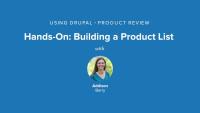Drupal’s theming system gives designers complete control over how a site’s content is rendered for a web browser, and custom themes can give any site a distinctive look. But sometimes it’s useful to make minor tweaks to a site’s appearance using nothing but CSS rules. They allow designers to tweak font sizes, colors, and so on without altering the underlying HTML that defines the site’s structure. In this lesson we'll look at:
- CSS Injector module
- Explain how this works
Additional resources
Although our “Product review” content type has all of the data we need, the individual reviews still look a bit untidy. In this lesson, we’ll do some final tweaking to make the review display look nice and tidy.
- Setting Field Display Options
- Configuring CSS Injector
Additional resources
Now that we have a few products, we really ought to add a listing page that lets visitors look over all of the products that have been reviewed, comparing official ratings with visitor ratings and sorting by various criteria. This is a perfect job for Views. In this lesson:
- Create a Product Finder view
- Display Amazon information
- Display voting results
Additional resources
A Guide to Drupal 8 at DrupalCon Austin
Blog postDrupalCon Austin is rapidly approaching and the big question on my mind is: What Drupal 8 sessions do I need to put on my radar? To figure that out, I've mined the schedule for Drupal 8 related talks and events and organized them a bit to help me – and hopefully you – find the Drupal 8 sessions not to be missed.
With so much information, and so many products, on the web today, people often want to get an opinion to help rank and rate things. Should I buy this widget? Should I watch this movie? In this series, we’re going to use a handful of Drupal modules to build a product review website that lets community members give their opinions, along with a way to rate their review as well. To kick things off, in this lesson we will:
- Review the Super Duper Chefs case study
- Discuss our implementation
Additional resources
In this week's release, we kick-off a new video learning series, Using Drupal Chapter 5: Product Reviews.
To get started, we'll need to create a content type to use for our product reviews. Based on the Super Duper Chefs requirements, in this lesson we'll:
- Create the Product Review Content Type
- Add a Field group
- Set permissions
Additional resources
Amazon.com is one of a large number of web-based businesses that have opened up their product information databases for other sites to access. In the case of Super Duper Chefs, we want to retrieve useful data like product photos, pricing, and manufacturer information for display on our own website. The Amazon module for Drupal allows us to do just that. In this lesson we'll take a look at the Amazon module, by starting with:
- What’s Included?
- Locale
- Referral settings
- Amazon keys
Additional resources
In a previous lesson in this series, we set up a content type for our product reviews. Now, we’re ready to add a field to store a link to the product on Amazon.com. In this lesson we'll:
- Enable and configure the Amazon module
- Get our Amazon key
- Add the Product Field
Note that Amazon changes the way they manage keys over time, so the way they are generated in the lesson may have changed. Please review the official AWS Product Advertising API documentation for current key generation instructions.
Additional resources
To transform the Product Finder page into a searchable index, we’ll be adding two new filters to the view: one that restricts the results by manufacturer, and another that restricts results to reviews that mention specific words. In this lesson, we'll:
- Add a filter
- Expose a filter
- Set permissions
Additional resources
Drupal 8's out-of-the-box mobile friendliness creates quite the buzz. "Mobile friendly," "responsive," "squishy" — all words to describe the behavior a site invokes on different devices or different screen sizes. Mobile friendly can also mean content first.
Drupalize.Me Podcast Episode 42
Blog postIn this week's episode, 42: Content Delivery Systems (CDNs), Addi is joined by two bots, Joe Shindelar and Ben Chavet, along with Will Hetherington, who is a network consultant for Drupalize
So far in the Mapping with Leaflet series, we've taken advantage of the field formatter provided by the Leaflet module to display a map on a page for a piece of content containing location data. This resulted in a single marker on a map. But what about a map of multiple locations? For this, we'll get to use Views and the Leaflet Views module that is included in the Leaflet project download. We'll also address a common problem of transforming postal addresses into geocoded data that a map can use. For this, we'll look at a solution that integrates Geocoder and Address Field modules. As a bonus, I'll walk you through the process of configuring a Feeds Importer to work with the esoteric and possibly confusing Address Field targets and I'll demonstrate how to import .CSV text file of postal addresses into Address Field, which is then geocoded and displayed on a Leaflet map.
Let's Debug Twig in Drupal 8!
Blog postWhen I am theming a Drupal site, I need to know which variables are available on a template file. In Drupal 8, the template engine is Twig, so we’re going to need to know a little bit of Twig to make this work. So, if Twig is totally new to you, don’t worry. Today, you’ll learn some Twig!
Drupalize.Me Podcast Episode 41
Blog postIn Episode 41, Virtualization with Vagrant, Emma Jane Westby and Erika Heidi chat about creating virtual environments with Vagrant. Through their light-hearted approach to technical topics, we hope Emma and Erika are able to make Vagrant seem a little more accessible, if not downright fun.
The concept of blocks has been around in Drupal since the earliest versions. Chunks of information that can be placed into the regions provided by a theme and re-used throughout your site. The system for defining blocks in code has changed quite a bit for Drupal 8 though so it's worth taking a fresh look at how to create blocks in your own module. Especially since in my experience it's one of the first things we need to know how to do as module developers.
Webinar: Easily Create Maps with Leaflet
Blog postCurious about Leaflet? Join Drupalize.Me Trainer Amber Matz for a live tutorial on how to add Leaflet maps to your Drupal site during this Acquia hosted webinar on May 1, 2014 at 1:00 PM EDT.
Hiding Form Fields in Drupal 8
Blog postIf you have worked with the Field UI in Drupal 7 you will know that you are able to prevent fields from being displayed when viewing entities (e.g. content, users etc).







